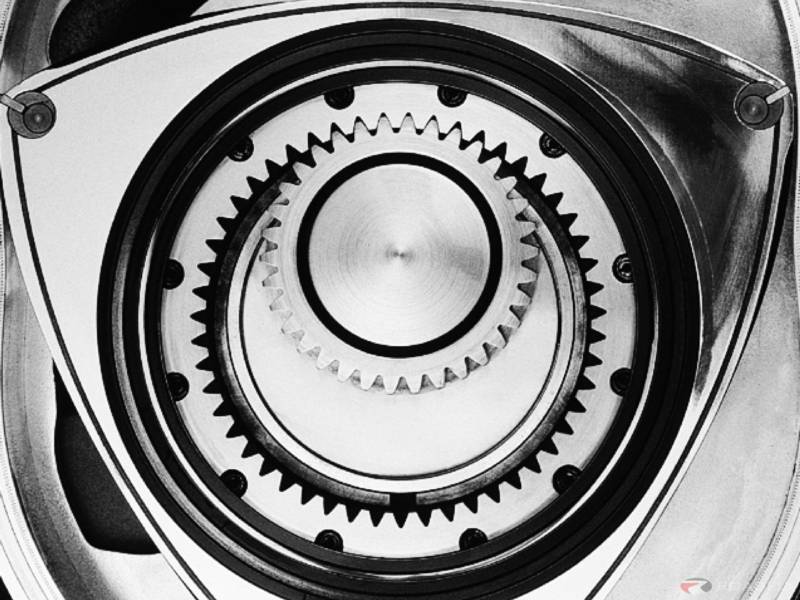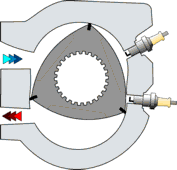
In the late '70s and early '80s AvtoVaz produced a 115/140hp Wankel rotary engine that is very similar in format to the Mazda rotary. It was fitted to various VAZ and GAZ cars, but not the Niva
 AUTOVAZ (Lada) rotary powered cars from Russia/USSR
AUTOVAZ (Lada) rotary powered cars from Russia/USSR

LADA logo (actually the Vaz parent company logo)
Several years ago there was a short article eluding to the existence of Wankel Rotaries made by Lada published in Fast Fours and Rotaries magazine. Since reading this article I found additional information on the Internet and have sourced a few pictures and tables of various engines produced. See below.
AutoVaz (or often reduced to just Vaz) is the parent company of Lada, kind of like GM with Chevrolet or Opel.
The first rotary car was made in 1978 - a single rotor powered Lada sedan based on a licensed Fiat design.
I understand that at least 8 different models of Lada sedan have been converted to rotary power and around 20 different variants of engine produced of 1, 2, 3 and reportedly 4 rotors.
I speculate that some of the engines are surprisingly similar to the Mazda 13B family; with some of the 2 rotors engines being 1308cc and the same rotor housing width as the 13B. Perhaps AutoVaz used Mazda parts as a template for their own early experiments? (Note, this is only speculation. I have not seen nor heard anything that would confirm this).
Fast Fours and Rotaries article
Note - This article appeared in Fast Fours and Rotaries magazine, sent to me by the author; see acknowledgements. I believe that it is based on a letter sent to the magazine from a reader in the USSR. Text is unedited by me (Unless noted).
Russian Rotaries
Quick, think of all the car manufacturers in the world that have produced rotary engined cars, bet most of you thought of Mazda. Many of you would have thought of NSU/Audi, and the odd really keen enthusiast may be aware of the Comotor/Citroen unit but almost no one would have thought of Lada.
During the summer of 1980 the Volga auto works of Tagliatti (called Auto-Vaz) sold about 250 rotary equipped Lada cars to customers under the imaginative Vaz-21018 designation. In this case a single rotor Vaz 311 rotary engine was installed in a basic Vaz-21011 body.
The power plants geometrical data will look surprisingly familiar to Mazda enthusiasts:
Engine type Vaz 311 (Single rotor)
RE = 102 mm (Craig comment - rotor eccentricity/trochoid dimension.)
ECC= 15 mm (Craig comment - Eccentric shaft/Rotor journal offset from centreline)
Rotor width = 80 mm
70 bhp @6000 rpm
95 Nm @3500-4000 rpm
Comp = 9.5:1
The compression is very high by Eastern bloc early 80s standards considering the 'high octane' Russian petrol was only rated for 93 RON.
The vehicles electric’s were considered sensational for the time. A black box which analysed inputs from the load, speed & rotor position transducers triggers a thyristor (Craig comment - electronic ignition), which fired the ignition coils. The spark plug design featured twin side electrodes.
A most unusual feature of this car was it’s cold starting device, an anti-freeze injection system. This part of the world can be very cold & when trying to start the thing at minus 25 Celsius some of the liquid anti-freeze needed to be squirted in, hoping to stop the plug electrodes from icing. A manual which came with the car suggested that this be tried only twice; three times and you flood the system with anti-freeze.
A standard down draught carburettor was used but with altered jet sizes and a two stage air cleaner was employed as well. The apex seals got their share of oil through a lubricator, and the oil level in the sump was maintained automatically.
A belt driven fan was upgraded to an electric type for latter versions.
I personally had no experience in performing a 'low temperature start'. In warm weather the rotary fired instantly & after warming it a bit, settled to steady idle of about 950 rpm. This particular car was fitted with a tacho by the owner (a racing driver) as none of these 21018 model cars received one at the factory (big mistake) .
Performance of the rotary seemed as good, or perhaps better than any 1.3 lt. Lada, but keeping the revs up was a must and a tacho becomes invaluable for better driving. What I instantly noticed, was the almost insignificant engine braking available from this tiny power plant, so the brake pedal got an extra work out as a result. The revs matched the accelerator pedal inherently. No where near the inertia of a piston engine, you lift the accelerator and the revs disappeared instantly.
Required driving style changes apart, it was a pleasant experience, but according to the little statistics that became available, many rotaries didn’t last to the first 10000 km filter change. Maximum engine life up to 20000 km was seemingly as per normal. In many cases the rotary was thrown out and replaced with a conventional four cylinder 1.3 Lada/Fiat motor.
End of and era, you suppose? With model 311, yes, but not with Autovaz’s aspiration within the Wankel league. Then came a long flirt with 2 rotor models. In 1982 some where seen installed in rally cars and those were as fast as 1.6 Ladas. Fed through 2 twin throat Webers DCOE’s meant at least 150 bhp was available from those developed for racing. A long silence followed, but suddenly in 1988, several engines were put on display at an exhibition in Moscow. A twin rotor Vaz 411-01 which had an equivalent capacity of 2300 cc & the same 120 bhp on tap. The model Vaz 413 with fractionally larger dimensions was rated 20 hp higher. No torque figures were given but both had 9.4:1 compression and weighed in at 130-140 kg per engine.
Some 411 engines were seen in Ladas, indexed as Vaz 21019. The more powerful models became available for Latvian made RAF buses & Ambulances. The KGB got some Volga sedans fitted with the larger rotary as power was about 1.5 times the standard 2.5 lt engine. Also, a 3 rotor Vaz 513 was released (equivalent to 3900 cc) and rated at 280 hp for it’s 200 kg engine weight. Max power of all said engines was quoted between 5500-6000 rpm.
So who in the USSR needed that sort of power? Good question. The answer is people in uniforms, 280 hp from a 3 rotor and at least 350 from a 4 rotor engine (which did exist as well) in a light weight package was a real day time dream for designers of lightly armoured fighting vehicles. We can say that perhaps Vaz 21018, 21019 were spin offs of some military program. There was never an intention to let Mr & Mrs average Russian behind the wheel of a rotary engined car. The few hundred produced were just a lucky break.
The Lada/Vaz range of cars
The AutoVaz company is parent to many divisions, including Lada, UAZ, ZIL, GAZ, and Volga.
There is a research centre called the GENDR (Short for the full Russian name). A subdivision of GENDR is the SKBRPD (Rotary Research Division) - This name comes from SKB = Special Design Agency, RPD = Rotary Piston Engine. The Russians usually refer to rotaries as "RPDs".
They seem to make about 100 rotary engined cars per year.
| Picture of Car | Information about the car |

(300x185) | The VAZ-21108 Car (first made in 1978) was powered by a single rotor VAZ-311 engine.
The VAZ-21109 Car was a minor update to this body shape but powered by a two rotor VAZ-411 engine.
This car was licensed from Fiat (Fiat 124 sedan)
The base model 4 cylinder engine was the VAZ-21101 (picture 289x200) |

(260x167) | The VAZ-21059 Car (first made in 1980) was powered by the two rotor VAZ-411M engine, and also the two rotor VAZ-4132 engine
Transmission was a 4 speed manual and the car had an optional extra fuel tank.
Again, this car was licensed from Fiat (based on the Fiat 131 sedan)
Price of car when new: Roubles 51,975 / $US 8316 / $AUS 13513
|

(259x196) | The VAZ-21079 Car (first made in 1982) was basically an updated version of the VAZ-21059 except it used the two rotor VAZ-411-01 engine, and the two rotor VAZ-4132 engine
Transmission was a 5 speed manual and the car had an optional extra fuel tank.
I believe the 4 Cylinder version of this model was made by Lada as a cheap car until as late as 1997!
Price of car when new: Roubles 57,870 / $US 9259 / $AUS 15046
Weight of Car: 1430 kg
Top Speed: 180 km/h, 0-100 km/h time: 9 Seconds
Fuel consumption, at 90 km/h: 9.5 litres per 100 km, and at 100 km/h: 12.5 litres per 100 km
|

(300x225) | The VAZ-2108-91 Car (first made in 1984) was powered by the two rotor VAZ-415 engine.
Transmission was a 5 speed manual.
This was the first Russian designed model, and was sold in several western markets as the Lada Samara.
The car in the photo seems to be some 1997 race champion.
Price of car when new: Roubles 56,300 / $US 9008 / $AUS 14638
Weight of Car: 1050 kg
Top Speed: 200 km/h, 0-100 km/h time: 8 Seconds
Fuel consumption, at 90 km/h: 7 litres per 100 km, and at 100 km/h: 10 litres per 100 km |

(300x181) | The VAZ-2109-91 Car was an updated VAZ-2108-91 (same drive train)
The car in the photo was a normal police car (called the MUD, this is not the KGB)
Price of car when new: Roubles 58,100 / $US 9296 / $AUS 15106
|
 | The VAZ-21099-91 Car was an updated VAZ-2108-91 (same drive train)
Price of car when new: Roubles 62,300 / $US 9968 / $AUS 16198
(no large picture available) |

(460x231) | The VAZ-2115-91 Car was an all new design and was powered by the two rotor VAZ-415 engine.
Transmission was a 5 speed manual.
Price of car when new: Roubles 75,700 / $US 12112 / $AUS 19682 |

(450x266)

(450x266) | The VAZ-2110 Car was supposedly powered by the two rotor VAZ-415 engine.
Unfortunately I can't find any more information on the rotary version. (Picture of crashed Racing Model)
|

(350x208) | The GAZ-3102 Car (First made in 1981) also known as the "Volga". Powered by the two rotor VAZ-411-01 engine (as used in the VAZ-21079 car above).
This car was also available with the 210hp 3 rotor VAZ-431 engine, supposedly used by the KGB.
Length 4960mm, Width 1800mm, Height 1422mm, Weight (4 Cyl version) 1850kg.
The 4 cylinder engines used were the ZMZ-406 (2.3l, 150hp, 170 km/h top speed)
or the ZMZ-402 (2.445l, 100hp, 147 km/h top speed) |







